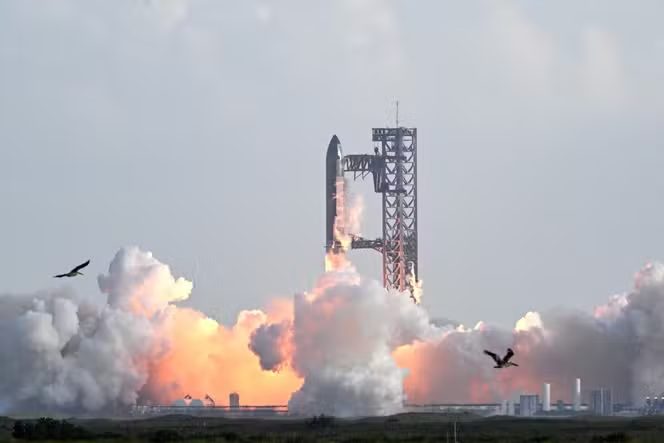SpaceX successfully launches Super Heavy-Starship on high-stakes test flight, marking one of the most ambitious steps in modern space exploration. This event, watched by millions around the globe, highlights the growing potential of reusable spacecraft and the future of interplanetary travel. For Elon Musk’s space company, the test flight was not only a technological milestone but also a symbolic step toward making human missions to Mars a reality.
- The Historic Launch
When the engines of the Super Heavy booster ignited, the skies above Boca Chica, Texas lit up with the roar of 33 Raptor engines. For nearly five minutes, the colossal rocket carried Starship toward the edge of space before separating from the booster.
Viewers described the launch as both “terrifying and awe-inspiring.” For engineers, this was a culmination of years of design, testing, and iteration.
A SpaceX spokesperson said: “This was a major step forward in demonstrating the viability of Starship as a fully reusable transportation system for humanity’s future in space.”
- What Makes the Super Heavy-Starship Special?
The Super Heavy-Starship system is the most powerful rocket ever built. Standing 397 feet tall, it surpasses NASA’s Saturn V and even the Space Launch System (SLS).
Key Specs:
- Height: 397 feet (121 meters)
- Engines: 33 Raptor engines on Super Heavy, 6 on Starship
- Thrust: 16.7 million pounds of force (twice that of Saturn V)
- Payload Capacity: Up to 150 metric tons to low Earth orbit
- Reusability: Designed for rapid re-flights with minimal refurbishment
This design is central to SpaceX’s mission of reducing space travel costs by reusing rockets, similar to how commercial airlines reuse planes.
- The Risks of a High-Stakes Test
The test flight was high-risk, with a history of explosive failures during early trials. Previous Starship prototypes exploded upon landing attempts, earning the nickname “Rapid Unscheduled Disassembly” (RUD) within SpaceX.
Elon Musk, known for his frankness, admitted before launch: “There’s a good chance this rocket doesn’t make it back in one piece, but every test is progress.”
This transparency helped temper expectations. Unlike NASA missions that must succeed flawlessly, SpaceX views each failure as data collection, accelerating its engineering process.
- Why This Launch Matters Globally
The successful launch of the Super Heavy-Starship carries global significance:
For NASA: Starship is a critical component of the Artemis program, which aims to return humans to the Moon by 2026. NASA has contracted SpaceX to develop a lunar lander version.
For Space Economy: Lowering launch costs could unlock industries like space mining, tourism, and manufacturing.
For Mars Exploration: This rocket is humanity’s first real chance at interplanetary colonization. Musk envisions Starship carrying 100 passengers at a time to Mars.
According to Dr. Lori Garver, former NASA Deputy Administrator: “Starship is not just about Musk’s Mars dream. It represents a paradigm shift in how we think about scaling space access.”
- What Comes Next for Starship?
Despite its successful lift-off, challenges remain:
Reusability Proof: Both the booster and Starship must land intact after flights. Achieving this will be critical for reducing costs.
Orbital Tests: Future flights will aim to complete a full orbit around Earth.
Human Safety: Crewed flights will require years of safety testing.
Regulatory Approvals: The FAA and international agencies will continue scrutinizing launches to protect public safety and the environment.
SpaceX plans multiple test flights in the coming year, each iteration bringing Starship closer to operational status.
Expert Perspectives
Space analyst Tim Fernholz stated: “If Starship works as designed, it will dwarf every other launch vehicle in history. It’s essentially building the railway to space.”
Meanwhile, critics raise concerns about environmental impacts and the risks of rushing development. Some argue that massive launches over sensitive ecosystems like Boca Chica could harm wildlife and communities.
Storytelling: Witnessing History
For many viewers in Texas, the launch was not just science—it was history unfolding. Families gathered along beaches, children pointed at the streak of light across the sky, and engineers at SpaceX’s mission control erupted in cheers.
One local resident told reporters: “It shook the ground beneath us. You could feel the power in your bones. It wasn’t just a rocket launch, it was the future taking off.”
Global Reactions
NASA Administrator Bill Nelson congratulated SpaceX, calling the launch “a milestone toward humanity’s next giant leap.”
Chinese space authorities monitored closely, viewing Starship as a competitor to their own Long March rockets.
European officials voiced cautious optimism, urging for international cooperation in space exploration.
FAQs
What is the SpaceX Super Heavy-Starship?
It is the largest and most powerful rocket system ever built, designed for reusability and interplanetary missions.
Why was this test flight important?
It demonstrated key systems and proved the viability of Starship for future lunar and Mars missions.
How powerful is the Super Heavy-Starship?
It produces 16.7 million pounds of thrust, making it the most powerful rocket in history.
What role does NASA play in Starship’s development?
NASA has contracted SpaceX to use Starship as part of its Artemis lunar missions.
What’s next for SpaceX after this launch?
SpaceX plans multiple test flights to perfect reusability and aims for orbital missions soon.
Conclusion:
The fact that SpaceX successfully launches Super Heavy-Starship on high-stakes test flight demonstrates that we are entering a new era of exploration. While many hurdles remain, the progress is undeniable.
Elon Musk’s vision of Mars colonies might still seem far-fetched, but every launch brings it closer. For humanity, this test flight wasn’t just about one company’s success—it was about expanding the frontier of possibility.














